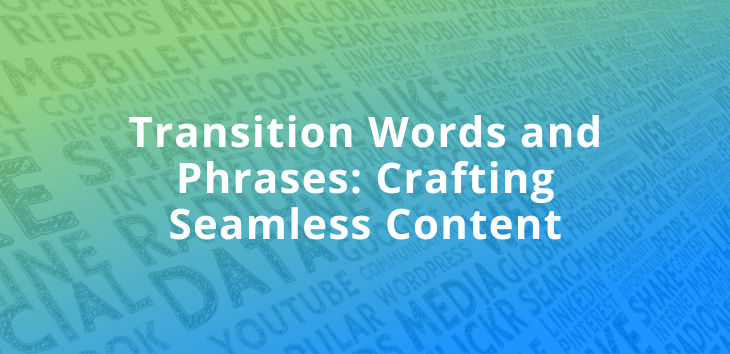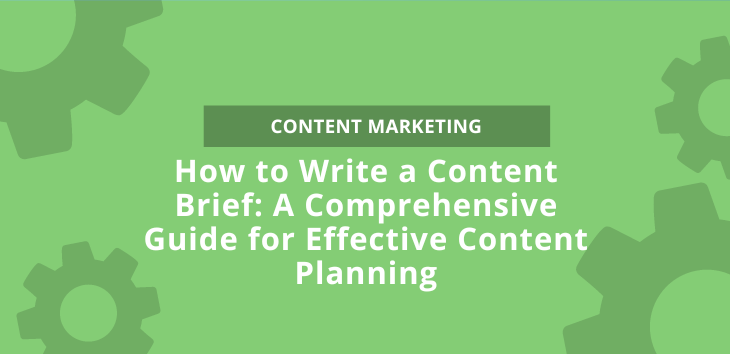Do you ever wonder why some websites keep you glued to the screen while others have you closing the tab faster than a toddler throwing broccoli on the floor? It all boils down to user experience (UX). That includes the invisible magic of transition words.
If you think of transition words as unnecessary frills, think again. They’re powerful weapons in your content marketing arsenal. Transition words move readers along your conversion funnel, just like clear site navigation and calls-to-action (CTAs). From a logic and flow standpoint, transition words enhance readability. Clear writing helps readers understand and engage with your message. Crucially, it’s something Google pays close attention to. For search engines, readability means a strong UX. It helps crawlers index your content and shows off your expertise and authority.
Using transition words is essential to effective content creation. Getting better at using them will captivate readers, improve SEO, and boost conversions. Discover our practical tips, strategies, and tools for using transition words and phrases to elevate your content for impactful, seamless communication.
What Are Transition Words and Phrases?
Transition phrases and words are mini bridges connecting sentences and paragraphs so readers can easily follow along. These little guys might seem like extras, but they play big roles. They show readers when you’re changing gears, introducing a new idea, or hammering home a point. Moreover, they make the reading experience more enjoyable by shaping the emotional arc and determining logical flow.
For readers to engage with your article’s message, they have to understand it. Sounds obvious, but it’s easier said than done. That’s because when you write, you know exactly what you’re trying to say. It’s easy to forget that readers aren’t inside your head.
To follow along with your writing and remain enthralled, readers need an extra nudge in the right direction. Transition words offer that guidance.
Innovative strategies for using transition words and phrases
If you have some writing experience, you likely know that overusing “and,” “but,” and “also” is a no-no. There’s a good chance you already connect paragraphs and sections with logical transitions and prioritize readability and clarity over excessive bridging. But there’s so much more to effectively using transition words.
Marketing expert Chase Dimond’s tried-and-true tip for starting paragraphs with an arresting transition is a good place to start.
Let’s explore more strategies for using transition words:
- Genre-specific strategies: Tailoring transition choices to specific content types elevates their impact. In a narrative, transition words keep up the story’s momentum by signaling time, location, or perspective changes. For example, words and phrases such as “meanwhile,” “later,” and “the next day” indicate shifts in the timeline. With technical writing, precise transitions such as “therefore” or “conversely” clarify arguments and move readers along. In commercial copy, transitions like “crucially” and “as such” influence how the reader interprets your writing. Understanding which transitions work best for each type of copy is vital. Using scientific, stuffy transitions in a blog post about cute dog outfits is just as bad as not using any.
- Strategic omission: Deliberately leaving out a transition in a high-stakes moment can build suspense. For instance, “The door creaked open, revealing darkness. Silence. Nothingness.” This device is especially effective in storytelling.
- Rhetorical questions: Asking questions engages readers by drawing them into and guiding them through the article.
- Technology: Text-to-speech software with advanced language modeling can make suggestions for transitions.
- Categories: Get up to speed with which transition terms best suit each narrative function.
Some transition phrases and words improve structural flow, while others connect ideas. They can subtly influence readers’ opinions and add weight to your arguments.
Transition Words List
Smooth transitions are the bedrock of clear writing. Imagine building a house without beams and supports – it would quickly crumble. Similarly, writing without transition words makes content choppy and unclear.
Here are the key transition categories, their functions, and sample words and phrases for each.
Structuring your writing
Have you ever watched a movie that cuts to a new screen saying, “One year later” or “Five years earlier”? Much like those cinematic shifts, the following structural transition words can set the flow of your content, allowing you to pivot seamlessly.
Use introduction transitions to set the scene:
first
to begin with
who would have thought
to start
today
these days
since
Condition transitions introduce hypothetical situations:
if
provided
unless
Time — these transitions establish the order of ideas or events:
after
afterward
before
as soon as
currently
during
finally
firstly
in the meantime
initially
lastly
presently
meanwhile
next
now
subsequently
then
thereafter
to begin with
ultimately
whenever
Order transitions arrange points logically:
first
next
second
then
third
Conjunction transitions link sentences and paragraphs:
and
but
for
nor
or
so
yet
Use summary transitions to wrap up your main points and make a memorable impression:
all in all
in brief
in conclusion
in essence
in short
in summary
on the whole
overall
wrapping up
to conclude
to summarize
Connecting ideas
Transition phrases that connect ideas show how your ideas relate to each other. They create a smooth flow and help readers see the bigger picture.
Digression transitions add brief thoughts or comments that support or challenge your main idea:
by the way
incidentally
that said
on the other hand
Use agreement transitions to show how your ideas connect in support of each other:
also
additionally
fortunately
what’s more
in addition
besides
correspondingly
equally
further
furthermore
in the same way
in the same vein
likewise
moreover
similarly
too
Add nuance to your ideas by using comparison transitions:
although
conversely
despite
even though
however
in contrast
on the other hand
otherwise
regardless
still
while
yet
Guiding the reader’s understanding
When you’re writing copy with a purpose, it goes without saying that you want to influence your audience. But guiding their understanding isn’t as straightforward as presenting an argument. You have to make sure they’re following you along every step of the way. How? By writing in a clear and engaging way, using these transitions to highlight key points and demonstrate authority.
Probability transitions set up your opinions and nudge readers toward a desired outcome:
likely
perhaps
probably
By using certainty transitions, you signal your authority and build trust:
certainly
as soon as
definitively
undoubtedly
without a doubt
Use emphasis transitions to highlight key points and ideas and secure them in readers’ minds:
certainly
definitely
in fact
indeed
notably
significantly
importantly
in particular
interestingly
more importantly
of course
perhaps most importantly
quite
what’s more
remarkably
specifically
truly
undoubtedly
Fine-tuning your argument
Transitions that fine-tune arguments add depth, nuance, and power to your writing. They acknowledge counterpoints, rephrase ideas for clarity, and show the cause-and-effect relationships between concepts.
Transitions that return to the main point help you circle back and reiterate your primary argument:
anyhow
anyway
on that note
that said
at any rate
in any case
Illustration transitions set up quotes and data — which are essential for making solid arguments:
for example
take
a study found
evidence shows
for instance
specifically
Similar to emphasis words, restatement transitions add weight to key points, but they do it via repetition:
in other words
put another way
to rephrase
Concession transitions acknowledge opposing views and demonstrate fairness and a well-rounded approach:
admittedly
although
even though
granted
of course
still
yet
Cause and effect transitions establish the causal relationships between events or ideas. They help readers understand the “why?”:
accordingly
as a consequence
as such
as a result
because
consequently
for this reason
hence
if so
since
so
therefore
thus
Transition Words and Phrases in Action
Engaging copy doesn’t have transition words in every sentence; it strikes a careful balance. Here’s an excerpt from LinkedIn’s most-read article of all time:
There’s no formula or perfect number of transitions per paragraph or 100 words. However, with millions of views, almost 40,000 likes, and 4,661 comments, Dr. Bradberry’s article is a resounding example of engaging copy. He uses transition words to clarify arguments, guide readers through the piece, and signpost salient points. The post has made — and continues to make — such an impact because it’s useful, actionable, and easy to follow.
Clunky, choppy, disjointed, and flat-out writing often needs smoother transitions. Dr. Bradberry’s article showcases readability’s power to make audiences and search engines happy.
Good vs. bad transitions in writing
The University of Alabama, in Huntsville, provides a solid example of ineffective vs. effective transitions in writing:
In the poor transition example, the two sentences lack a smooth connection, which may cause readers to take a moment to discover or realize the connection. Therefore, readers might lose interest or stop trusting what they’re reading at that moment. As a brand or marketer, your ability to convince and convert rests upon that trust — so each transition is precious.
The better transition example makes it clear that the sentences are connected, guiding. readers, along so they understand effortlessly.
Pressbooks’ Writing Textbook provides another example of bad transitions in writing. This post highlights how effective transitions are by removing just 16 words from a passage of text.
Look how much of an impact omitting the transition question between the two paragraphs has:
The writer outlines their argument in a rhetorical question that concludes the first paragraph. They answer it in the second, tying the ideas neatly together. See how much of a difference a simple transition can make?
How to Weave Transition Words Into Your Writing
Now, you’ve seen how other writers use transitions to clarify their writing and engage readers. It may take some practice, but learning how to use transition words effectively will be time well spent
Here’s a quick guide on using transition words in your writing:
- Map your masterpiece: Before putting pen to paper, brush up on transition categories and words. Then, keep transitions in mind as you create your content outline. Where will you use contrast? Where will you add emphasis? This roadmap helps you create a smooth flow. Always do a final proofread for clarity and flow.
- Think beyond basic transitions: While the words “and” and “but” are unavoidable, be sure to explore richer options. “As such,” for example, signals cause and effect, while “on the other hand” implies an opposing viewpoint.
- Variety is key: Never fall into the trap of monotony. Combine short transitions with longer ones, using strong verbs and active voice to keep readers engaged.
- Transition within sentences: Don’t limit transitions between paragraphs. Use them creatively within sentences to emphasize your argument and keep readers engaged.
- Read aloud and ruthlessly revise: Once your draft is complete, read it aloud. This exposes clunky transitions and areas where smoother connections are needed.
Mastering transition words is no longer an advanced writing technique authors and scientists use. It’s a content marketing superpower. Transitions give you a competitive edge in a world where engaging content and strong SEO intertwine.
As our VP of Content Operations, Rick Leach, says:
“While the definition of good writing can be hard to pin down, it relies heavily on transitions. With well-written content, readers forget they’re making an effort. It flows from sentence to sentence, paragraph to paragraph, and section to section. Transitions soften abrupt shifts from one idea to the next. In short, they help readers see the bigger picture without making them scratch their heads.”
Transition Words, SEO, and Readability
Attention spans are decreasing, and the digital marketplace is swelling. Plus, as search engine algorithms grow increasingly complex, the bar for SEO-friendly content keeps rising. With so much content competing for clicks, transitions are nonnegotiable for keeping readers hooked.
Here’s how:
- Enhanced Readability: Transitions transform a series of disjointed sentences into a cohesive, comprehensible whole. This translates to higher engagement and longer dwell times, both things that Google loves.
- Improved SEO: Thoughtful transitions unpick relationships between keywords and concepts. This aids search engines in understanding your content’s context and relevance.
- User Engagement: Well-placed transitions keep readers moving forward with ease. Intuitive UX directly impacts SEO by encouraging people to keep exploring your content.
As you write, experiment with transitions beyond the familiar, and you’ll see results in both readership and rankings.
Transition Word Toolbox
Crafting smooth transitions is an art form. But, you don’t have to go it alone. This toolbox is brimming with resources that help you elevate your transition game. Each one can help you get better at writing transitions that connect, captivate, and convert.
AI-powered language tools
You can also utilize artificial intelligence to analyze your writing and provide suggestions tailored to your goals:
- Grammarly Business: An advanced grammar checker that suggests contextual transitions that seamlessly connect ideas.
- QuillBot: This AI-powered paraphrasing tool analyzes your text and recommends sophisticated synonyms for transition words.
- Writesonic: An AI writing assistant with a feature that restructures sentences for better flow, suggesting improved transitions in the process.
Advanced text analysis platforms
Move beyond spell-check. The following platforms delve deeper, offering feedback on sentence structure, transition variety, and potential areas for improvement.
- StyleWriter: Provides insights into sentence complexity and transition variety. It suggests areas where transitions can be strengthened to enhance clarity and flow.
- Cliche Finder: Scans your text for overused phrases, including generic transitions such as “however” or “in addition.” This tool recommends more specific and engaging alternatives.
Interactive style guides and writing communities
Sometimes, the best insights come from your fellow wordsmiths. Online communities and style guides offer collaboration, expert advice, and ongoing learning:
- ProWritingAid Community Forums: This online forum allows writers to share draft excerpts and receive feedback on transition effectiveness.
- Hemingway Editor: A writing tool that analyzes text for readability and highlights areas with complex sentence structure, prompting you to break down complex ideas.
Master Transitions to Increase Conversions
By now, you understand that transition words are much more than stylistic frills. They’re the invisible architects of engaging, SEO-friendly content. Transitions guide readers effortlessly through your content, ensuring they grasp your message and remain engaged. At the same time, they signal to search engines how your ideas connect, enhance content visibility, and showcase your expertise.
The bottom line? Content that’s easy to follow is more persuasive.
Crowd Content has an entire network of skilled, experienced writers. Our rigorous multi-step editorial process ensures every piece of content is clear and concise and flows perfectly.
You can discover how our expertise in content strategy can elevate readers’ engagement with your website content and enhance SEO by diving into our Content Strategy Services. There you’ll learn how to effectively use transition words and phrases to create structured, persuasive content.




